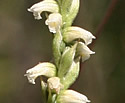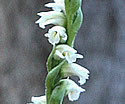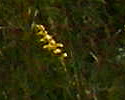Spiranthes casei (Case's Ladies'-tresses)
| Also known as: | |
|---|---|
| Genus: | Spiranthes |
| Family: | Orchidaceae (Orchid) |
| Life cycle: | perennial |
| Origin: | native |
| Status: |
|
| Habitat: | part shade, sun; average to dry soil; barrens, open woods, outcrops, sand pits, mine tailings basins |
| Bloom season: | August - September |
| Plant height: | 6 to 14 inches |
| Wetland Indicator Status: | none |
| MN county distribution (click map to enlarge): |  |
| National distribution (click map to enlarge): |  |
Pick an image for a larger view. See the glossary for icon descriptions.
Detailed Information
Flower: 

![[photo of flowers]](/udata/r9ndp23q/pd/spiranthes-casei-739-17-t.jpg) A single row of 14 to 35 creamy white to yellowish, nodding flowers spiraling up at the tip of the stem. Individual flowers are ¼ to 1/3 inch long, the sepals and lateral petals remaining nearly closed with only the tip of the lower petal's slightly frilly lip perceptibly unfurled down, the inside of the lower lip often tinged a darker yellow. An erect, green oval-lance bract encloses the ovary at each flower's base. The spiral usually has 5 or more flowers per cycle.
A single row of 14 to 35 creamy white to yellowish, nodding flowers spiraling up at the tip of the stem. Individual flowers are ¼ to 1/3 inch long, the sepals and lateral petals remaining nearly closed with only the tip of the lower petal's slightly frilly lip perceptibly unfurled down, the inside of the lower lip often tinged a darker yellow. An erect, green oval-lance bract encloses the ovary at each flower's base. The spiral usually has 5 or more flowers per cycle.
Leaves and stems: 


![[photo of leaves]](/udata/r9ndp23q/pd/spiranthes-casei-739-23-t.jpg) The 2 to 5 basal leaves are narrow to oblong lance-shaped, 4 to 7¾ inches long and 1/3 to ¾ inch wide, toothless and hairless, usually persisting through flowering, The few stem leaves are erect to spreading and reduced to scale-like bracts. The stem is rigid, smooth and hairless at the base with sparse to dense short hairs (pubescent) into the flower spike.
The 2 to 5 basal leaves are narrow to oblong lance-shaped, 4 to 7¾ inches long and 1/3 to ¾ inch wide, toothless and hairless, usually persisting through flowering, The few stem leaves are erect to spreading and reduced to scale-like bracts. The stem is rigid, smooth and hairless at the base with sparse to dense short hairs (pubescent) into the flower spike.
Notes:
Spiranthes casei was not recognized as a unique species until the mid-70s and it probably showed up in Minnesota for the first time around that period, though it was not discovered here until 2000. Most likely, the fine, powdery-like seed blew in from populations in Wisconsin or Upper Michigan and took a liking to the fine mineral soils created by taconite tailings found in catch basins in Itasca and St. Louis counties. While its range in Minnesota is severely limited to this human created environment, it is relatively easy to run down in this habitat. It does however share this habitat with the more common and widely distributed Nodding Ladies'-tresses (Spiranthes cernua), but can be distinguished by: its single row of spiraling flowers (vs. 2 or 3 rows in S. cernua), its creamy, yellowish flower color (vs. pure white), wider basal leaves, and the minimal flaring (vs. widely flaring) of flower petals and sepals. There are 2 varieties in North America, with var. novaescotiae limited to southern Nova Scotia and var. casei found elsewhere in its range, including Minnesota. S. casei is currently listed as a tracked species in Minnesota, but is likely to change to a State Threatened status due to its rarity in the state, apparent specialized habitat, and the fact that mining companies are pushing to reopen operations in those locations, putting its existence in Minnesota in jeopardy. We shall see how this turns out.
Native Plant Nurseries, Restoration and Landscaping Services ↓
More photos
Photos courtesy Peter M. Dziuk taken in Itasca and St. Louis counties.
Comments
Have you seen this plant in Minnesota, or have any other comments about it?
on: 2013-08-10 15:13:42
Could I have possibly seen this flower in Anoka County? I have never seen it before, but it sure resembles the Case's Ladies'-tresses. But it is not indicated this far south on the habitat/range map. Just wondering??? I'll have to go back out and try to find it again and bring along my field guides!!
on: 2013-08-10 18:04:57
Most likely what you came upon was Spiranthes cernua, nodding ladies'-tresses, which is pretty common in Anoka county. S. casei is only found in old mining tailings basins in 2 northern MN counties.
on: 2014-11-23 08:44:31
The genetic work for this species has been done by a Phd student at the University of Wisconsin- Madison, Matthew Pace. According to Matthew's work S. casei are ecotypes or variants of the same species, S. ochroleuca. In the future the species will be described as either S. ochroleuca var. casei or just S. ochroleuca.







 Case's Ladies'-tresses plant
Case's Ladies'-tresses plant more plants
more plants Case's Ladies'-tresses habitat
Case's Ladies'-tresses habitat